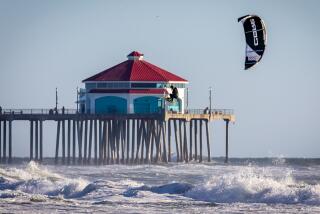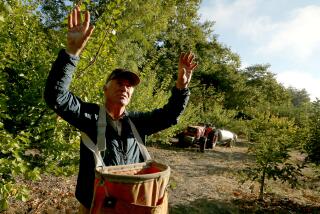Cold Does Major Damage to Crops : Agriculture: Hard hit are citrus, lettuce, broccoli, avocados and artichokes. Price increases predicted.
- Share via
The California cold snap has caused major damage to the state’s $8-billion fruit and vegetable industry, destroying substantial portions of the citrus crop and affecting lettuce, broccoli, avocado and artichoke crops from San Diego to Santa Cruz, experts say.
Consumers almost certainly will face sharp price increases at grocery produce departments, and growers are exhausted from several nights of trying in vain to raise temperatures in their fields by means of wind, fire, water and even a spray-on plastic coating.
“It’s the most extensive damage I’ve seen, ever,” said Clark Briggs, a spokesman for the California Farm Bureau Federation, a private organization representing about 45,000 farmers.
The Los Angeles County administrative office anticipated millions of dollars in agricultural losses.
Several experts predicted that supermarket prices will rise by at least 50% for California navel oranges and winter vegetables.
The most devastating damage apparently was in the central portion of the state.
At least one death was attributed to the freeze, a transient who died of hypothermia in Anaheim. The 57-year-old man was found in convulsions under a recycling center trailer at a grocery store. His name was withheld until relatives could be notified, an Orange County coroner’s official said.
The chill continued for a third day Sunday throughout the state. The overnight temperature at the Los Angeles Civic Center, 34 degrees, was one degree warmer than the all-time low for Dec. 23.
But record lows for the date were set elsewhere: in Riverside, at 22 and in San Diego at 36.
In Bakersfield the low reached 18, with temperatures below 25 for 12 hours. In the Bay Area, records were set in San Francisco (a reading of 31) and Oakland (26 at the airport).
Shelters for the homeless once more were filled to capacity.
From the San Fernando Valley to San Francisco, water pipes burst and plumbers reported running low on insulation and pipe. Santa Cruz County officials declared a local state of emergency, with hundreds of residents reporting frozen and broken pipes and many going without water.
Meteorologists expect the Arctic air mass that has been hovering over California to dissipate over the next two days, with highs in Los Angeles reaching the lower 60s today and lows possibly reaching as high as the 40s.
Meanwhile, farmers will take the measure of their losses.
“Citrus is essentially wiped out in the San Joaquin Valley,” said National Weather Service meteorologist Dan Gudgel, who surveyed growers in the region, where about 200,000 acres are planted. He said 70% of the harvest was still on trees in Fresno and Tulare counties, with 50% unharvested in Kern County. Wide variations were found from orchard to orchard; some growers’ crops were nearly all picked, others had not begun.
The crystallized fruit has the taste and texture of Popsicles.
One grower in the Fowler-Sanger area, southeast of Fresno, said a navel orange he tested “was so frozen I had to put it on the ground” to try to cut through it. “I was sawing through it like a baseball.”
“Last night was the killer night,” said the grower, Richard Berberian, a farmer for 27 years. “The navel is gone. The Valencias are gone, the Minneolas are gone, the lemons are gone.”
In the east end of the valley near the Sierra foothills, grower Tom Mulholland said of the area’s orange belt: “We’re declaring a 100% crop failure.” He estimated that at least 80% of the area’s fruit had frozen in the fields.
Keith Nilmeier said he expects to lose his $90,000 investment in this year’s citrus crop, grown on 400 acres near Fresno.
“My swimming pool . . . is a solid sheet of ice,” he said. “If I wanted weather like this, I would have moved to the Midwest.”
Citrus trees, especially those under 3 years old, also appear damaged, which could lead to significant long-term losses. Leaves have faded, curled under and blackened at the tip. Growers said the next two weeks will provide evidence of life or death. If the bark splits, the tree will not survive.
In the Inland Empire, near Redlands, and in the San Bernardino area, about 20% of the citrus crop on about 400 acres was lost to the freeze, said Daniel Elva of DJC, a farmers’ information network.
Other crops around the state were affected as well.
Joe P. Prandini, general manager of Betteravia Farms Co. near Santa Maria, estimates that he has lost about 35% of his cauliflower crop on his 4,000-acre farm and said the company has stopped harvesting celery.
“It’s the worst I’ve ever seen,” said Prandini, who sent workers home on Saturday because the crop was still frozen at noon.
Avocado stems froze in Ventura County, causing the fruit to drop to the ground.
Everywhere, farmers stood all-night vigils in their fields. Some used wind machines to try to bring warmer air closer to the ground. Others used water to encase their crop in an ice shield. Some used heaters. A few used a newer technique of spraying on an invisible polymer that coats leaves with plastic to protect the trees.
Some were more successful than others.
In Orange County, growers said Sunday they had managed to protect the county’s $168-million nursery and strawberry crops from serious damage.
In San Diego County, the frost meant “we’ll have some loss, but it won’t be devastating,” said Wilbur Shigehara, an agricultural meteorologist for the National Weather Service. “Last night was our only critical night here.”
The county has 30,000 acres of citrus, 30,000 acres of avocados and thousands of acres of strawberries, Shigehara said.
Some citrus growers complained that more fruit would have been harvested already if not for a federal marketing policy set by a nine-member navel orange administrative committee that meets in Newhall each week to decide how many oranges should be picked and shipped.
They blamed five committee members, representing the Sunkist cooperative, who have been voting to hold back oranges.
One Sunkist grower said the oranges have been left on the trees because the fruit has been low in sugar. The industry was waiting for peak sweetness, he said.
In non-agricultural areas, the main concern was frozen water pipes. In the Antelope Valley, said Los Angeles County Sheriff’s Sgt. David Webster, “People are calling up 911 and informing us they don’t have water. These houses were not built to withstand weather below 10 degrees.”
“We’re basically like an emergency room,” said Canyon Country plumber Kurt Bohmer, as his telephone rang furiously with calls from frantic customers.
The dispatcher for D&D; Rooter and Plumbing in Lancaster said that even her employer’s home had been without water for two days.
Also contributing to this story were Times staff writers Kristina Lindgren and Sonni Efron in Orange County; Alan Abrahamson in San Diego; Steve Padilla in the San Fernando Valley and correspondent Mark Arax in Fresno.
More to Read
Inside the business of entertainment
The Wide Shot brings you news, analysis and insights on everything from streaming wars to production — and what it all means for the future.
You may occasionally receive promotional content from the Los Angeles Times.










